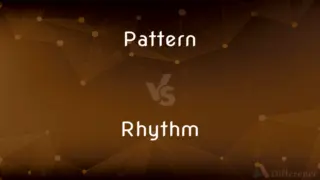Marten vs. Sable — What's the Difference?
Edited by Tayyaba Rehman — By Fiza Rafique — Updated on April 1, 2024
Martens are agile forest-dwelling carnivores, whereas sables are a specific type of marten valued for their luxurious fur.

Difference Between Marten and Sable
Table of Contents
ADVERTISEMENT
Key Differences
Martens belong to the genus Martes within the Mustelidae family, known for their slender bodies and bushy tails, adapted to forest living. On the other hand, the sable is a specific species within the marten family (Martes zibellina), distinguished by its dark, valuable fur.
While all martens are recognized for their agility and tree-climbing abilities, sables are particularly noted for their fur, which has been a luxury item in the fashion and fur trade for centuries. Whereas martens have a broader geographic distribution, including Europe and North America, sables are primarily found in Russia, Japan, and some parts of Mongolia and China.
Martens have a varied diet that includes small mammals, birds, and insects. Sables, while having a similar diet, are especially adept at hunting in the snowy environments of the taiga, showcasing their specialized survival adaptations.
The habitat of martens varies widely, with different species adapted to a range of forested environments, from the deciduous forests of Europe to the coniferous forests of North America. Sables, however, specifically thrive in the dense, cold forests of the taiga, where their dark fur provides both warmth and camouflage.
Both martens and sables play significant roles in their ecosystems as predators that help control populations of smaller animals. However, sables have faced greater hunting pressure due to the high value of their fur, which has led to conservation efforts specifically aimed at preserving their populations.
ADVERTISEMENT
Comparison Chart
Species
Genus Martes
Martes zibellina
Distribution
Europe, Asia, North America
Russia, Japan, Mongolia, China
Habitat
Broad range of forests
Dense taiga forests
Diet
Small mammals, birds, insects
Similar, with adaptation to taiga environment
Fur
Varied, less commercially valued
Dark, luxurious, highly valued in fur trade
Conservation
Subject to habitat and hunting pressures
Specific conservation due to fur trade pressures
Role in Ecosystem
Predators, control small animal populations
Similar, with adaptations to cold environments
Compare with Definitions
Marten
Agile, forest-dwelling carnivores.
The pine marten leaped from tree to tree in search of prey.
Sable
A type of marten with luxurious fur.
The sable's dark fur is highly prized in the fur trade.
Marten
Conservation varies by species.
Some marten populations are stable, while others face threats from habitat loss.
Sable
High fur value.
Sable fur has historically fetched high prices in fashion markets worldwide.
Marten
Broad habitat range.
Different marten species adapt to various forest environments globally.
Sable
Native to cold taiga forests.
Sables thrive in the dense, snowy forests of the Russian taiga.
Marten
Varied diet.
Martens hunt small mammals and birds, supplementing with fruits and insects.
Sable
Conservation efforts due to fur trade.
Conservation efforts for sables focus on sustainable fur trade practices.
Marten
Bushy-tailed and slender.
The marten's slender body and bushy tail are perfect for its arboreal lifestyle.
Sable
Specialized in taiga hunting.
Sables are adept at hunting prey in the challenging conditions of the taiga.
Marten
The martens constitute the genus Martes within the subfamily Guloninae, in the family Mustelidae. They have bushy tails and large paws with partially retractile claws.
Sable
The sable (Martes zibellina) is a species of marten, a small omnivorous mammal primarily inhabiting the forest environments of Russia, from the Ural Mountains throughout Siberia, and northern Mongolia. Its habitat also borders eastern Kazakhstan, China, North Korea and Hokkaidō, Japan.
Marten
Any of several mustelid mammals of the genus Martes, mainly inhabiting northern forests and having a slender body, bushy tail, and soft fur.
Sable
A mustelid mammal (Martes zibellina) of northern Eurasia, having soft dark commercially valuable fur.
Marten
The fur of one of these mammals.
Sable
The pelt or fur of this animal.
Marten
Any carnivorous mammal of the genus Martes in the family Mustelidae.
Sable
The similar fur of other species of martens.
Marten
A bird. See Martin.
Sable
The color black, especially in heraldry.
Marten
Any one of several fur-bearing carnivores of the genus Martes (formerly Mustela), closely allied to the sable. Among the more important species are the European beech marten or stone marten (Martes foina); the pine marten (Martes martes); and the American marten, or sable (Martes Americana), which some Zoologists consider only a variety of the Russian sable.
Sable
Sables Black garments worn in mourning.
Marten
The fur of the marten, used for hats, muffs, etc.
Sable
A grayish yellowish brown.
Marten
Agile slender-bodied arboreal mustelids somewhat larger than weasels
Sable
A sablefish.
Sable
Of a grayish yellowish brown.
Sable
Of the color black, as in heraldry or mourning.
Sable
Dark; somber.
Sable
Of the fur of the sable
A sable coat.
Sable
(countable) A small carnivorous mammal of the Old World that resembles a weasel, Martes zibellina, from cold regions in Eurasia and the North Pacific islands, valued for its dark brown fur (Wikipedia).
Sable
(countable) The marten, especially Martes americana (syn. Mustela americana).
Sable
The fur or pelt of the sable or other species of martens; a coat made from this fur.
Sable
(countable) An artist's brush made from the fur of the sable (Wikipedia).
Sable
(tincture) A black colour on a coat of arms (Wikipedia).
Sable
A dark brown colour, resembling the fur of some sables.
Sable
Black garments, especially worn in mourning.
Sable
The sablefish.
Sable
Of the black colour sable.
Sable
(tincture): In blazon, of the colour black.
Sable
Made of sable fur.
Sable
Dark, somber.
Sable
Dark-skinned; black.
Sable
A carnivorous animal of the Weasel family (Mustela zibellina) native of the northern latitudes of Europe, Asia, and America, - noted for its fine, soft, and valuable fur.
Sable
The fur of the sable.
Sable
A mourning garment; a funeral robe; - generally in the plural.
Sable
The tincture black; - represented by vertical and horizontal lines crossing each other.
Sable
Of the color of the sable's fur; dark; black; - used chiefly in poetry.
Night, sable goddess! from her ebon throne,In rayless majesty, now stretches forthHer leaden scepter o'er a slumbering world.
Sable
To render sable or dark; to drape darkly or in black.
Sabled all in black the shady sky.
Sable
An artist's brush made of sable hair
Sable
The expensive dark brown fur of the marten
Sable
A very dark black
Sable
A scarf (or trimming) made of sable
Sable
Marten of northern Asian forests having luxuriant dark brown fur
Sable
Dark somewhat brownish black
Common Curiosities
Can sables be found outside of Russia?
Yes, sables are also found in northern Japan, Mongolia, and northeastern China, though the largest populations are in Russia.
Are martens endangered?
The conservation status of martens varies by species and region; some are stable, while others are threatened or endangered due to habitat loss and hunting.
What makes a sable fur so valuable?
Sable fur is valued for its fine, soft texture and rich color, which have made it a luxury item in the fur industry.
Why are sables specifically targeted for their fur?
Sables have been targeted for their fur due to its high quality, warmth, and luxurious appearance, making it highly sought after in the fur trade.
How do martens and sables adapt to their environments?
Martens adapt to a broad range of forested environments, while sables are specialized for survival in the cold taiga with adaptations like dense fur for warmth.
Do martens and sables have natural predators?
Yes, both face predation from larger carnivores such as wolves and eagles, and they are also threatened by human activities.
Are there any legal protections for sables?
Yes, sables are protected under various national and international laws that regulate hunting and trade to prevent overexploitation.
What is the difference in diet between martens and sables?
While both have similar carnivorous diets, sables have specific adaptations for hunting in the snowy environments of the taiga.
How do sables contribute to their ecosystem?
Sables control populations of rodents and other small animals, contributing to the ecological balance of their habitats.
Can martens and sables coexist in the same habitat?
While they may overlap in some areas, sables tend to inhabit colder, denser taiga forests, whereas other marten species occupy a broader range of forest types.
Do martens hibernate?
Martens do not hibernate; they remain active throughout the year, even in cold climates.
What efforts are being made to conserve sables?
Conservation efforts include regulating hunting, establishing protected areas, and promoting sustainable practices in the fur trade.
How do martens hunt?
Martens are agile predators that hunt both on the ground and in trees, using their sharp claws and teeth to catch prey.
What is the lifespan of a sable?
In the wild, sables can live up to 7 years, but they can live longer in captivity with proper care.
What challenges do sables face today?
Challenges include habitat loss, hunting pressure for their fur, and climate change affecting their taiga habitats.
Share Your Discovery

Previous Comparison
Pattern vs. Rhythm
Next Comparison
Heme vs. HaemAuthor Spotlight
Written by
Fiza RafiqueFiza Rafique is a skilled content writer at AskDifference.com, where she meticulously refines and enhances written pieces. Drawing from her vast editorial expertise, Fiza ensures clarity, accuracy, and precision in every article. Passionate about language, she continually seeks to elevate the quality of content for readers worldwide.
Edited by
Tayyaba RehmanTayyaba Rehman is a distinguished writer, currently serving as a primary contributor to askdifference.com. As a researcher in semantics and etymology, Tayyaba's passion for the complexity of languages and their distinctions has found a perfect home on the platform. Tayyaba delves into the intricacies of language, distinguishing between commonly confused words and phrases, thereby providing clarity for readers worldwide.















































